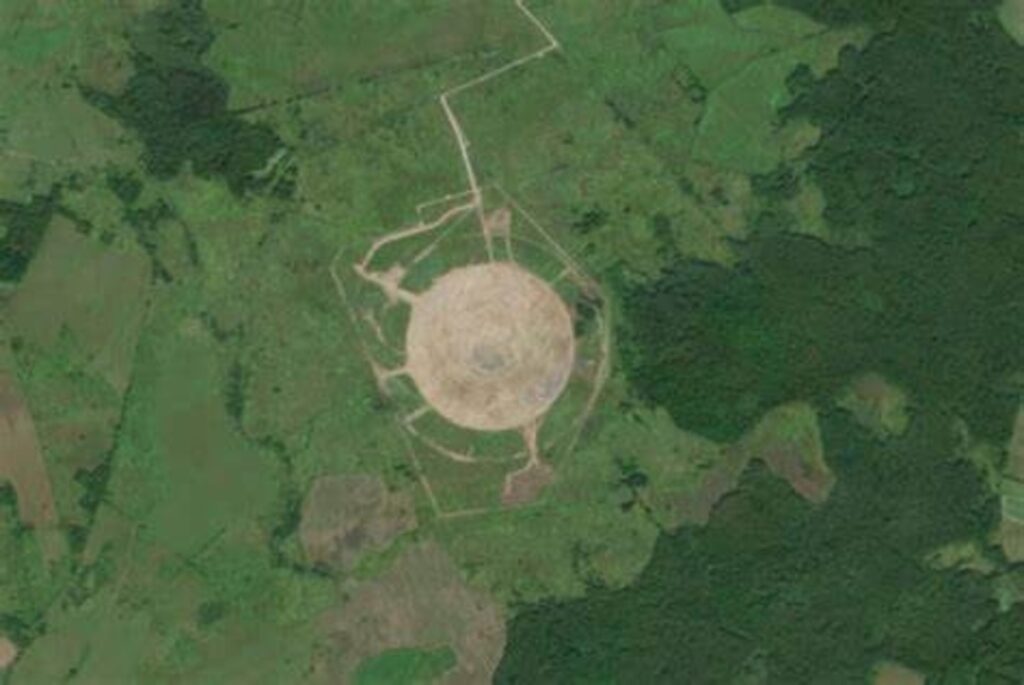Recent satellite imagery has uncovered a captivating and enigmatic new formation in Kaliningrad, Russia—an expansive 1200-meter-wide circle, which is approximately the size of 12 football fields. This peculiar site has piqued interest among analysts, leading to its ominous moniker: the Kaliningrad Monster. Located a mere 25 kilometers from the Polish border, this discovery has intensified curiosity, particularly given Kaliningrad’s strategic significance.
The Kaliningrad Enclave: A Geopolitical Focus
Kaliningrad, a Russian enclave sandwiched between Poland and Lithuania, sits strategically along the Baltic Sea. This prime location has established it as a crucial point for Russia’s military footprint in Eastern Europe. It provides not only maritime access but also functions as a significant military base, offering a commanding oversight of NATO’s maneuvers.
Given this backdrop, it’s no wonder that the emergence of such a substantial structure near one of Russia’s principal military facilities has garnered attention from both local and global observers. The enigmatic circle was initially detected by those analyzing satellite images, which are readily available online. But what exactly is this enormous structure, and what purpose does it serve?
The Radar Enigma: What Lies Behind the ‘Kaliningrad Monster’?
The Kaliningrad Monster, as it’s become known, seems to be linked to an advanced radar system called the 29B6 Container, which is a long-range over-the-horizon radar. This system has the capability to track objects such as missile launches or clusters of aircraft from distances greater than 3000 kilometers. It plays a vital role in Russia’s early-warning systems.
First unveiled in 2013, the Container radar system was initially set up in Mordovia, around 500 kilometers southeast of Moscow. By March 2020, Russian authorities announced plans for a second Container radar station to be established in Kaliningrad, which adds even more weight to the significance of this circular formation. However, at the time, the timeline for construction or the operational status of this radar remained uncertain.
Insights from Satellite Imagery
The 1200-meter-wide circle observed in satellite imagery is believed to be related to the establishment of the Container radar. This structure is likely intended to serve as an essential component of the radar system’s stationary base. The progress of this radar station is being monitored through a collection of satellite images compiled by the Radio & Nukes account on X (formerly Twitter), a social media outlet dedicated to disseminating open-source research on military advancements.
Current satellite images indicate that the radar stations are under construction approximately 15 kilometers southwest of the massive circle, positioned to enhance monitoring capabilities over European airspace, including the United Kingdom. This extensive radar network is designed to provide thorough coverage of the entire continent, enabling Russia to detect and address potential threats well ahead of time.
Impacts on European Security
The association of the Kaliningrad Monster with the 29B6 Container radar adds a new layer of complexity to European security issues. With its ability to identify threats from vast distances, this radar system is a critical part of Russia’s surveillance capabilities, especially in light of ongoing military engagements. The strategic placement of such a system near the Polish border underscores rising tensions in the region, particularly with NATO forces stationed in adjacent countries.
For those monitoring global security dynamics, the development of these radar facilities in Kaliningrad transcends mere technological progress; it signals Russia’s strategic intentions and efforts to enhance its defense architecture. The Kaliningrad Monster is not just an intriguing satellite curiosity—it symbolizes a broader and more urgent geopolitical reality that could alter the balance of power in Eastern Europe.
While the intrigue surrounding this massive structure has certainly captivated the public’s imagination, the real narrative unfolds in its military implications and the ongoing situation in the Kaliningrad region. Whether it will shift the course of European security remains to be seen, but currently, the Kaliningrad Monster serves as a stark reminder of the interplay between geopolitics and technology in an increasingly uncertain world.







